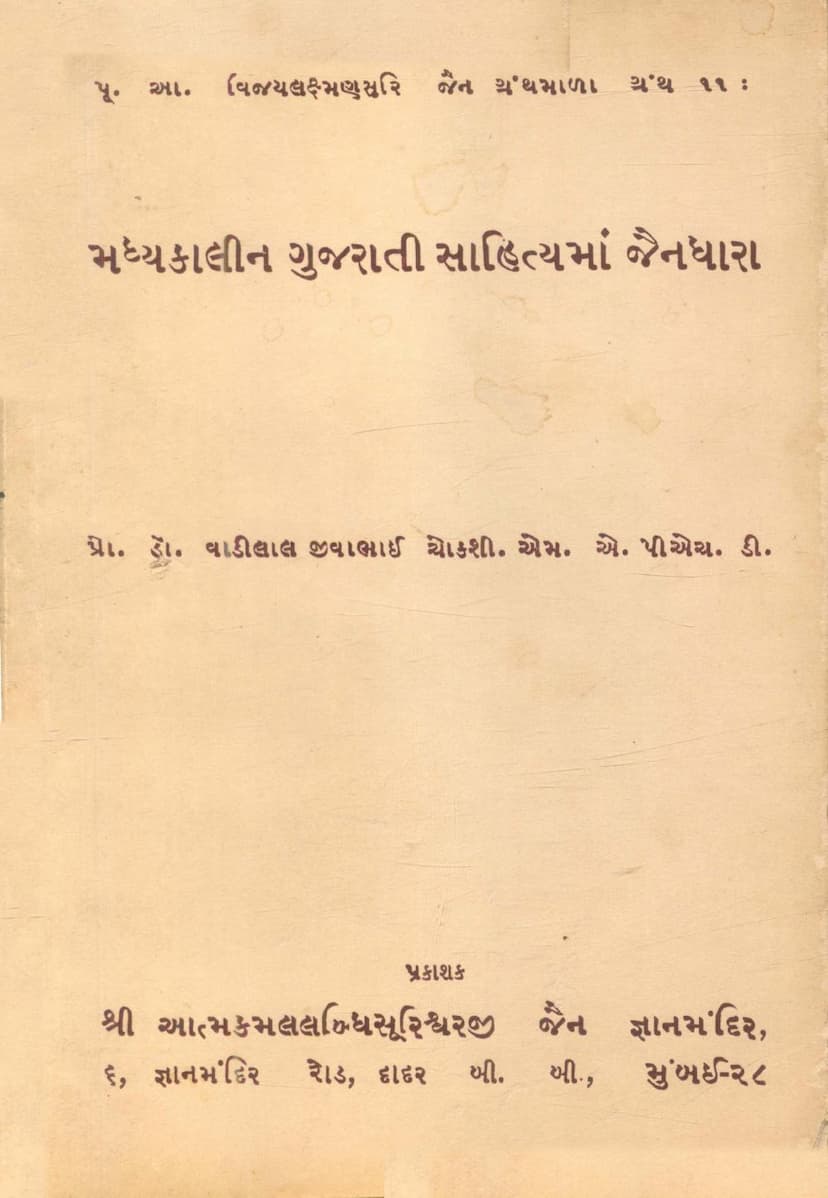Madhyakalin Gujarati Sahityama Jain Dhara
Added to library: September 2, 2025

Summary
Here is a comprehensive summary of the Jain text "Madhyakalīn Gujarati Sahityamā Jain Dhārā" by Dr. Vadilal Jivabhai Chokshi, based on the provided pages:
Book Title: Madhyakalīn Gujarati Sahityamā Jain Dhārā (The Jain Stream in Medieval Gujarati Literature) Author: Dr. Vadilal Jivabhai Chokshi Publisher: Shri Aatmakamal Labdhisuri Jain Gnanmandir, Bombay Year of Publication: 1979
This book, published as part of the Pū. Ā. Vijaylakshman Suri Jain Granhtmālā, focuses on the significant contribution of the Jain tradition to the development of Gujarati literature during the medieval period.
Core Argument:
The central thesis of the book is that the Jain tradition played a foundational and pivotal role in the genesis and early development of Gujarati language and literature. The author argues that much of the initial literary output in Gujarati, spanning from the 12th century up to the mid-19th century (the medieval period), originated from Jain poets, scholars, and patrons.
Key Themes and Content:
-
The Jain Genesis of Gujarati Literature: The book establishes that the earliest literary works in the Gujarati language emerged from the Jain tradition. It traces the linguistic and literary evolution from Apabhramsa literature to Old Gujarati and then to medieval Gujarati. The author highlights that Jain poets were the pioneers in developing key literary forms like 'Ras' (narrative poems) and prose works.
-
Chronological Overview of Jain Literary Contributions:
- 12th Century: This period is identified as the "Vajrasen Shālibhadra Suri Era," marking the beginning of Gujarati literature with works like 'Bhareshvar Bahubali Ghaur' by Vajrasen Suri and 'Bhareshvar Bahubali Rāsa' and 'Buddhi Rās' by Shālibhadra Suri. These works primarily featured the 'Ghar' and 'Rās' poetic forms.
- 13th Century: Known as the "Dharma-Vinay Era," this century saw fourteen Jain poets producing eighteen literary works. Forms like Ras, Chaturpādikā, Sandhi, Chaupāī, and Chācharī were explored. The first prose works, 'Arādhanā' and 'Bālshikshā' by Jagadu, also emerged from the Jain tradition during this period.
- 14th Century: This was a highly productive century for Jain literature, with 39 Jain poets contributing 53 works. It witnessed the continuation of the Ras tradition with longer compositions like Shālibhadra Suri's 'Panch Pandav Charitra Ras' and Shālisuri's 'Virātparva.' The origin of Gujarati folk narratives (LōkKathā) is also traced back to Jain poets like Vijaybhadra with his 'Hansraj Vachharāj Chopāī.'
- 15th Century: This period marks a significant shift with the emergence of prominent Jain poets like Naysundar, Samaysundar, and Rishabhdas, leading to what is called the "Naysundar-Samay-Rishabh Era" in Jain literature. While Jain literature continued to flourish with various forms like Ras, Prabandh, Fāg, Vārtā, and Geet, the secular (Jainetar) stream also gained momentum with figures like Narsinh Mehta. However, Jain poets like Naysundar, Samaysundar, and Rishabhdas significantly contributed to enriching Gujarati literature with their devotional and philosophical poetry, earning them a distinguished place alongside secular literary giants.
- 17th Century (First Half): This era is characterized by the "Akho Era" in secular literature and the "Naysundar-Samay-Rishabh Era" in Jain literature. Jain poets like Naysundar, Samaysundar, and Rishabhdas produced high-quality poetic works. The influence of Jain philosophical poetry (Jñānāshrayī) is seen, mirroring the trend in secular literature. The prose literature from the Jain tradition also saw significant development, with numerous authors and works contributing to the growing body of Gujarati prose.
- 17th Century (Second Half) & 18th Century: This period saw the rise of secular Gujarati literature with poets like Premānand and Shāmalbhat dominating the scene, particularly in the realm of Ākhyān (narrative poems). While the Jain stream continued with devotional and philosophical poetry (Sajjhāyā, Pūjā, Stavan), the secular tradition gained more prominence in narrative forms. The author notes a growing influence of secular literary trends on Jain poets during this later period.
-
Jain Prose Literature: The book emphasizes that the initial development of Gujarati prose also largely stems from the Jain tradition. From the 13th century onwards, Jain scholars produced numerous prose works, including commentaries (Bālāvadha), religious treatises, and narratives, significantly contributing to the formalization of Gujarati prose.
-
Key Jain Poets and Their Contributions: The text details the contributions of numerous Jain poets and prose writers across different centuries, highlighting their specific genres and the quality of their work. Prominent names mentioned include Vajrasen Suri, Shālibhadra Suri, Dharam, Vinayachandra, Naysundar, Samaysundar, Rishabhdas, Anandghanji, and Yashovijayji.
-
The Role of Jain Scholars and Patrons: The book implicitly highlights the role of Jain scholars and monastic orders in preserving and promoting literature, as well as the patronage provided by Jain lay individuals and communities.
-
Contribution to Medieval Gujarati Literature: The author asserts that without the substantial contributions of Jain poets and writers, the landscape of medieval Gujarati literature would be incomplete and significantly different. The Jain stream provided a continuous and rich literary tradition that laid the groundwork for later developments.
-
Appreciation of Rishabhdas: The book includes a dedicated study of the poet Rishabhdas, recognizing his significant contribution to Gujarati literature, particularly his works based on the Sanskrit 'Hirasaubhāgya Mahākāvya' by Devavimal Gani.
-
Modern Contributions: The book also briefly touches upon the contributions of modern Jain Acharyas, specifically Acharya Vijaylabdhisurishwarji and Acharya Vijaykirtichandrasurishwarji, to contemporary Gujarati literature, acknowledging their poetic and scholarly output.
Overall Significance:
"Madhyakalīn Gujarati Sahityamā Jain Dhārā" is a scholarly work that aims to rectify a historical oversight by highlighting the foundational role of Jainism in shaping Gujarati literature. It provides a chronological and analytical overview of this crucial period, demonstrating the depth and breadth of Jain literary output. The book serves as an essential resource for students, researchers, and anyone interested in the history of Gujarati literature and the significant cultural contributions of the Jain community.